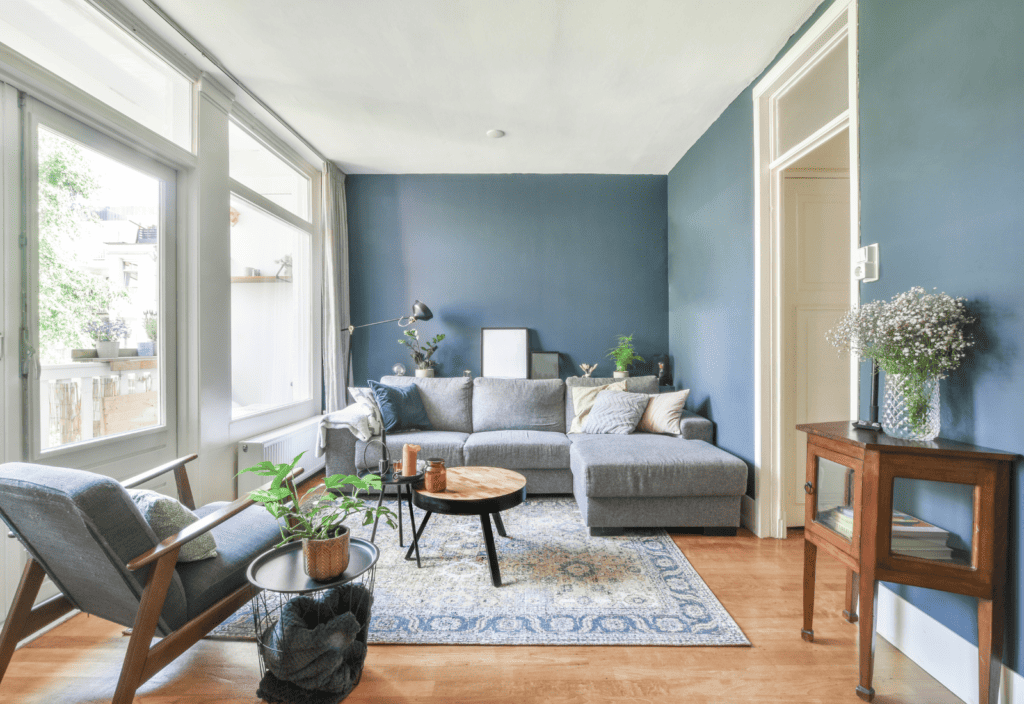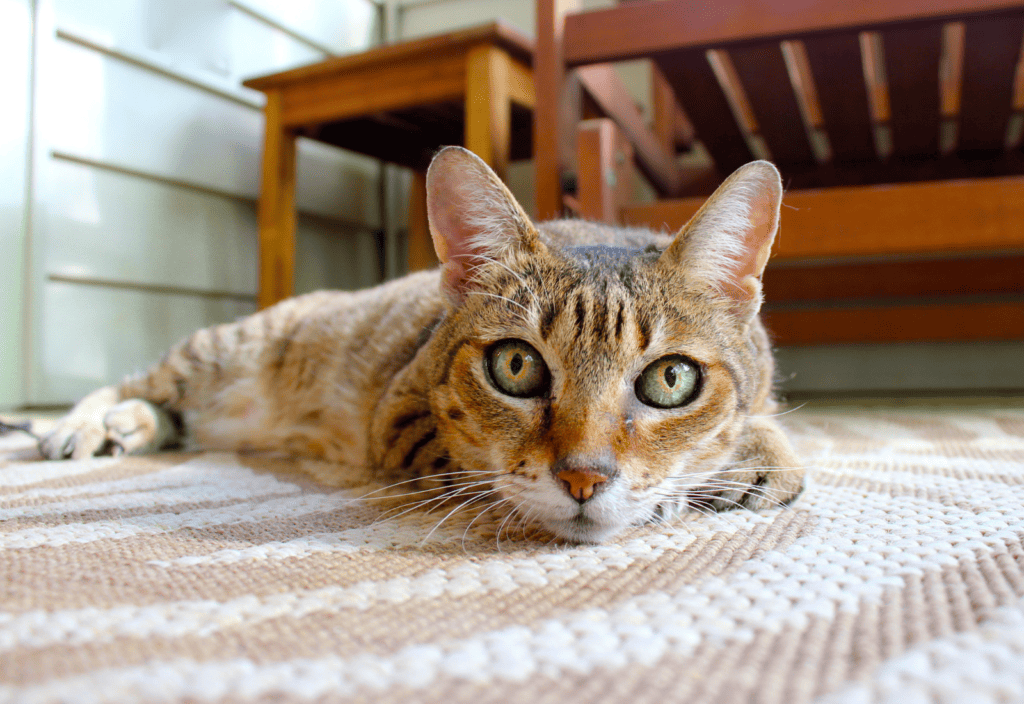Traditional rugs can contain toxins including flame retardants, formaldehyde, polypropylene and benzene. Like many things in our homes, they emit VOCs that pollute our indoor air. When it comes to cultivating a low toxin nursery, playroom or home, organic rugs and OEKO-TEX rugs are top options to consider.

Most inexpensive rugs are made from polyester and/or polypropylene, which are essentially just plastics. You not only have the fabric to think about but also the glue and backing used. One specific rug backing to avoid is PVC, which is toxic from production to finish and linked to cancer.
Without going too far down the never-ending rabbit hole let’s look at a few simple rules for rugs that will help you reduce your exposure to toxins. The first rule is to just say no to stain, flame and moth resistant rugs. Here’s why.
Stain, Flame and Moth Resistant Rugs
Resistant rugs can be some of the most toxic. I’m talking about a traditional rug from say Home Depot that has a resistant (to something) label. These labels are code for “extra toxins.” If it’s resistant, it’s been treated with something to make it that way.
It’s similar to those dress shirts that don’t wrinkle … their secret is a small amount of formaldehyde. Unfortunately, most conveniences come at a cost.
Flame resistant rugs are treated with flame retardants, which are harmful to human health. Nylon and polypropylene rugs, which originate from petroleum, are commonly treated with fire retardants because they are inherently flammable.
Stain resistant rugs are treated with perfluorinated chemicals (PFCs), which are forever chemicals meaning they never break down in the environment. PFCs have a strong link to cancer, reproductive problems, birth and developmental defects, and even immune system suppression.
Natural Fiber Rugs
Some of the most common natural rug fibers are cotton, jute, hemp and wool. Seagrass is a newer natural fiber that has recently come on the scene. Non-organic cotton can be heavily treated with pesticides, but overall is a safer choice.
If you can find and afford an organic cotton rug, it should contain little to no pesticide residue.
Moth treatment is something to inquire about when shopping for natural fiber rugs as moths. Most eco-friendly companies will not treat fabric for moths, but it never hurts to double check. The best safe protection against months is regular vacuuming and monitoring.
Moths like areas that are undisturbed and dusty (i.e., under furniture); however, they don’t like the smell of cedarwood, so you might consider spraying your rug from time to time with a water/cedarwood mixture.
Moths are active in the warm months, so you can rest easier once it gets cold.
OEKO-TEX Certification
Standard 100 by OEKO-TEX is one of the world’s best-known labels for harmful substance testing in textiles. The label ensures that every component of a piece of clothing free of harmful substances and nontoxic to humans.
While there has been a huge increase in number of products carrying this certification in recent years, I did not see many rugs boasting this label. I assume this is because it’s harder to meet these standards when crafting an area rug verses, say, a bath towel. I did find the label on a few rugs.
GOTS Certified Organic
GOTS (Global Organic Textile Standard) is the worldwide leading textile processing standard for organic fibers, including ecological and social criteria. This is an independent certification that is available to the textile industry.
This post contains affiliate links. At no cost to you, I may earn a small commission on qualifying purchases. Your support means so much to me.
As a focus on sustainability, GOTS evaluates the processing and manufacturing of textiles on the basis of both, environmental and social criteria. This includes assessments on everything from the chemical inputs used to the ethical treatment of workers. A company must meet all criteria to obtain a GOTS certification.
The GOTS standard covers the processing, manufacturing, packaging, labelling, trading and distribution of all textiles made from at least 70% certified organic fibers. There are two GOTS label-grades: “organic” requiring a minimum of 95% organic fibers and “made with organic materials” requiring at least 70% organic fibers.
This is definitely the gold standard when it comes to fabric.
Organic Natural Fiber Rug Options (1st choice)
These are a few of the safest rugs on the market. Due to the sourcing of materials, safety and certifications required, these rugs are significantly more expensive than common rugs. In an effort to keep it real, I do not own any of these “best” rugs, but I have considered Hook and Loom a few different times.
If these rugs are not in your budget, no worries, we’ll look at some more affordable options as well.
Organic Weave
Organic Weave offers rugs for all rooms of the house. The rugs are made from certified organic fibers and natural dyes. They contain no flame retardants or moothproofing chemicals. These rugs come in lots of color many of which would look great in a nursery or kids room.
Fair warning, these are the most costly of the rugs in this post. They are also made to order, and they take six weeks to arrive. You’ll definitely want to plan ahead if you want to order one of these high quality, organic rugs. Like most of the rugs in this post, Organic Weave rugs are made in India.
Willaby
Willaby is new to me! They are organic, machine washable and hand made by the Amish. Their manufacturing process is especially sustainable with no electricity use during production and no fabric waste. Wow!
They have color options in tan, pink, white and ivory. These rugs are machine washable. At the time of this post a 5 x 8 rug will run you just under $600.
Hook and Loom
Hook and Loom offers various types of rugs. While all of their rugs are great, safe choices, they recently added an organic line. The organic rugs don’t contain any dyes, so they are the natural cotton color. They are free of all the toxins you can think up and the most natural rug I am aware of.
Not a fan of off beige? Their other rugs come in more color options but all are still neutral in tone. The company uses low impact dyes hints, and the rugs are made in India. I know several people who own Hook and Loom rugs, and feedback has been very positive.
From strictly a safety and cost standpoint, Hook and Loom would be my choice if I decided to splurge on an organic rug. They are as safe as the first two choices at half the cost. I personally can’t speak to appearance and quality comparisons.
OEKO-TEX Natural Fiber Rugs (2nd choice)
West Elm/Pottery Barn
West Elm and Pottery Barn are under the same ownership, so their products are similar in quality and style. Both stores offer natural fiber rugs and combination rugs (natural and synthetic fibers) and utilize recycled materials when possible.
To my knowledge, neither stores allow added flame retardants, but you should definitely pick out a specific rug and shoot them an email to confirm. West Elm and Pottery Barn are known for their quality and commitment to sustainability.

Safavieh
Safavieh offers more traditional looking rugs with lots of fabric and color options. Keep in mind when shopping Safavieh, that their rugs differ greatly in fabric, backing and construction. They offer standard machine-made polyester rugs as well as hand-knotted cotton rugs.
You will want to check out their wool and cotton offerings if your goal is to limit toxins. The company has stated they do not treat any of their rugs with flame retardants. The company also has verified high sustainability standards. Safavieh rugs are made in India.
As for the price point, I have been able to snag two 11 x 14 wool area rugs for under $300 on two different occasions. I have absolutely loved both of them! I did have to shop around a bit to find a wool rug in my price range.
Overstock and Wayfair carry a large selection of Safavieh rugs. You can look at the rugs and gather information on the Safavieh website, but you will be directed to Overstock to make the purchase.
Synthetic OEKO-TEX Rugs (3rd choice)
Opal House
I was already familiar with the Opal House brand but didn’t realize they made rugs also. I was pleased to see that some Opal House rugs are made from natural fibers and/or OEKO-TEX certified. They are similar to Safavieh where materials and safety varies so be sure to read the description well.
Opal House rugs can be found on the Target website.
Threshold
I always like to offer a budget pick, because a cleaner lifestyle shouldn’t just be for the elite. Threshold rugs, sold at Target, are OEKO-TEX certified. They are made of synthetic fibers but the certification ensures they are least safety tested for the most harmful toxins. While not a perfect option, this is a better option than any ole rug with no certifications.
Conclusion
Organic rugs (GOTS certified organic) are the safest option available followed by natural fiber/OEKO-TEX rugs then natural fiber rugs then, lastly, synthetic fiber/OEKO TEX rugs. Hopefully, one of these options will match up with your preferences and make its way into your home.
If you happen to be putting together a nursey or playroom, be sure to check out my related post, Baby Safe Paint, for zero VOC paint options. As always, thanks for trusting me to share information with you!
